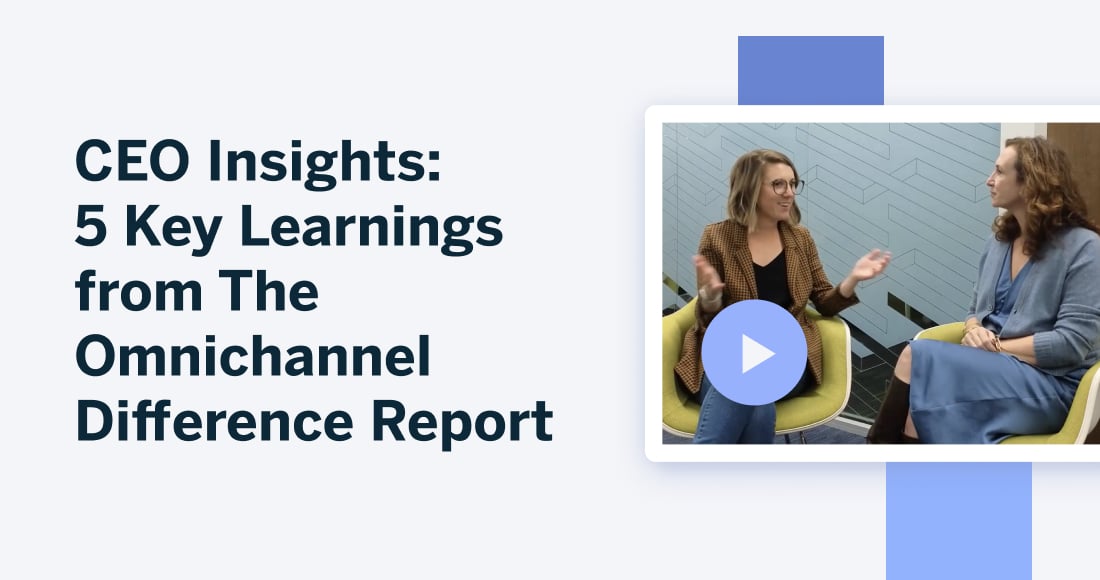SAP Emarsys CEO Joanna Milliken and Product Marketing Director Megan Hostetler talk data, channels, and findings from The Omnichannel Difference 2024.
At SAP Emarsys, we’re obsessed with omnichannel marketing. That’s why, when the opportunity to revamp our industry-leading whitepaper, The Omnichannel Difference, came up, we simply couldn’t resist.
Compiled from surveys of over 161 manager-level and above respondents from consumer-focused businesses, The Omnichannel Difference report is an exploration into how the most customer-obsessed companies deliver on the value of omnichannel. Packed full of statistics and valuable insights, it’s a must-have for any marketer exploring the impact of true omnichannel marketing.
In this exclusive interview, Megan Hostetler, Director of Product Marketing at SAP Emarsys, delves into some of her favorite statistics from the report, sharing them with CEO Joanna Milliken for her expert insight. Let’s take a look.

Insight 1: Omnichannel Efforts Yield Tangible Business Benefits
The Omnichannel Difference found: 46% of respondents noted increased customer lifetime value due to the depth of omnichannel customer engagement.
💡 Key insight: Omnichannel marketing isn’t just a buzzword — it’s your key to delivering value, both for your business and your customers. Think about it — your customers are everywhere, switching channels like they change clothes. They expect you to keep up, to be there, wherever “there” is for them.
It’s not just about being present across key channels. It’s about being smart about where and how you show up, and this is the core principle of omnichannel marketing. It’s proven, it’s effective, and it’s what sets you apart in a crowded, ever-changing marketplace. When brands adopt an omnichannel approach and see that it works first-hand, it’s even more validating.
Insight 2: The Appetite for Omnichannel is there, but Adding New Channels isn’t Easy
The Omnichannel Difference found: 46% of surveyed businesses have organizational and data silos that deter the free flow of information and impede a unified view of the customer.
💡 Key insight: The results from The Omnichannel Difference highlight the positive impact that omnichannel marketing can have. In fact, 36% of businesses, just like yours, are planning to add a new channel this year. But let’s not sugarcoat it — building a successful omnichannel marketing strategy and building new channels into that strategy can be tough, especially with a tight timeframe. You might not have the team for it yet, and there are a number of product and process challenges that come with the new territory.
However, while 46% of respondents stated organizational and data marketing silos were holding their omnichannel marketing strategy back, SAP Emarsys is here to make it easy to integrate data in a single customer engagement platform.
Marketers need to be thinking about content, relevancy, and making that data actionable — not the constructs of turning on a new channel. Testing and implementing new channels needs to be simple, because we as marketers do it so often. Speed to market. Consistent personalization. Next new channel. That’s what Emarys does best.
Insight 3: Data is the Key to the Kingdom
The Omnichannel Difference found: 44% of respondents cited lack of data analysis skills as the biggest challenge holding back their omnichannel strategy.
💡 Key insight: Today, data is not just a part of the strategy — it’s the heart of it. We’re talking about dynamic product recommendations, creating relevancy at every touchpoint a brand has with a consumer.
We’re not just capturing data; we’re actively creating it, and it’s not just about having data — it’s what you do with it that counts.
The Omnichannel Difference found that 44% of businesses struggle with data analysis, seeing it as a major roadblock in their omnichannel strategy. But let’s flip that script and start thinking of this as an opportunity. We need IT and data experts more than ever to help us decode this goldmine. Data is your key to understanding your customers on a deeper level, tailoring their experiences, and ultimately, driving your business forward. So let’s embrace it, let’s harness it, and let’s use it to create marketing magic.
Insight 4: Marketing and IT isn’t a Dependency, it’s a Partnership
The Omnichannel Difference found: 83% of surveyed organizations have regular meetings between marketing and IT, ensuring strategies, progress, and challenges are transparently discussed.
💡 Key insight: In the world of omnichannel, marketing and IT aren’t just crossing paths — they’re joining forces. This partnership is an essential collaboration. Each channel, be it an established one or a new addition for your brand (like TikTok, Mobile Wallet, or SMS) brings its own set of challenges and requirements. Think GDPR, which is the number one concern in our report — it’s a complex issue, and marketing teams can’t tackle it alone. They need the expertise and support of IT.
72% of respondents admit a heavy reliance on IT, and 83% have set up regular meetings to ensure transparency and free flow of information between departments. This is a testament to the integral role IT plays in the success of omnichannel marketing. The most successful customer-obsessed businesses recognize this, with 83% having set up regular meetings to ensure transparency and free flow of information between departments.
IT needs to be viewed as a strategic partner that empowers marketers to innovate, integrate, and engage effectively across all channels. So, let’s celebrate this dynamic duo and leverage their combined strength to revolutionize how we connect with our customers.
Insight 5: Customer Engagement Platforms Fast-Track Consistent Personalization
The Omnichannel Difference found: 40% of respondents struggle with providing personalized product recommendations based on browsing history.
💡Key insight: We’re in an era where the margin for error is razor-thin — it takes very little to lose a customer. That’s why every interaction, every engagement must be tailored to your customer’s expectations.
40% of businesses surveyed in The Omnichannel Difference struggle with personalizing product recommendations based on browsed products. It sounds simple enough, but personalizing these recommendations, and then making them consistent across your channels, is anything but.
That’s where your customer engagement platform steps in.
Your customer engagement platform collects and activates your data, turning it into a powerful tool to create meaningful, consistent product recommendations, no matter where your customer is. In the race for customer loyalty, your customer engagement platform is your secret weapon to creating personalized experiences that foster deep, lasting connections with your customers.












